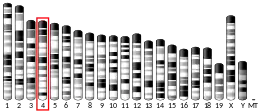SNAPC3
snRNA-activating protein complex subunit 3 is a protein that in humans is encoded by the SNAPC3 gene.[5][6]
| SNAPC3 | |||||||||||||||||||||||||||||||||||||||||||||||||||
|---|---|---|---|---|---|---|---|---|---|---|---|---|---|---|---|---|---|---|---|---|---|---|---|---|---|---|---|---|---|---|---|---|---|---|---|---|---|---|---|---|---|---|---|---|---|---|---|---|---|---|---|
| Identifiers | |||||||||||||||||||||||||||||||||||||||||||||||||||
| Aliases | SNAPC3, PTFbeta, SNAP50, small nuclear RNA activating complex polypeptide 3 | ||||||||||||||||||||||||||||||||||||||||||||||||||
| External IDs | OMIM: 602348 MGI: 1916338 HomoloGene: 31130 GeneCards: SNAPC3 | ||||||||||||||||||||||||||||||||||||||||||||||||||
| |||||||||||||||||||||||||||||||||||||||||||||||||||
| |||||||||||||||||||||||||||||||||||||||||||||||||||
| |||||||||||||||||||||||||||||||||||||||||||||||||||
| |||||||||||||||||||||||||||||||||||||||||||||||||||
| |||||||||||||||||||||||||||||||||||||||||||||||||||
| Wikidata | |||||||||||||||||||||||||||||||||||||||||||||||||||
| |||||||||||||||||||||||||||||||||||||||||||||||||||
References
- GRCh38: Ensembl release 89: ENSG00000164975 - Ensembl, May 2017
- GRCm38: Ensembl release 89: ENSMUSG00000028483 - Ensembl, May 2017
- "Human PubMed Reference:". National Center for Biotechnology Information, U.S. National Library of Medicine.
- "Mouse PubMed Reference:". National Center for Biotechnology Information, U.S. National Library of Medicine.
- Henry RW, Ma B, Sadowski CL, Kobayashi R, Hernandez N (December 1996). "Cloning and characterization of SNAP50, a subunit of the snRNA-activating protein complex SNAPc". The EMBO Journal. 15 (24): 7129–36. doi:10.1002/j.1460-2075.1996.tb01104.x. PMC 452539. PMID 9003788.
- "Entrez Gene: SNAPC3 small nuclear RNA activating complex, polypeptide 3, 50kDa".
- Ma B, Hernandez N (February 2001). "A map of protein-protein contacts within the small nuclear RNA-activating protein complex SNAPc". The Journal of Biological Chemistry. 276 (7): 5027–35. doi:10.1074/jbc.M009301200. PMID 11056176.
- Hirsch HA, Gu L, Henry RW (December 2000). "The retinoblastoma tumor suppressor protein targets distinct general transcription factors to regulate RNA polymerase III gene expression". Molecular and Cellular Biology. 20 (24): 9182–91. doi:10.1128/MCB.20.24.9182-9191.2000. PMC 102176. PMID 11094070.
Further reading
- Bagramian ER, Bogdanova EA, Krymskaia ML, Sokovykh SI (February 1977). "[Diagnostic importance of determining 17-ketosteroids in gynecology]". Akusherstvo I Ginekologiia (2): 65–7. PMID 900378.
- Henry RW, Sadowski CL, Kobayashi R, Hernandez N (April 1995). "A TBP-TAF complex required for transcription of human snRNA genes by RNA polymerase II and III". Nature. 374 (6523): 653–6. Bibcode:1995Natur.374..653H. doi:10.1038/374653a0. PMID 7715707. S2CID 4325527.
- Bai L, Wang Z, Yoon JB, Roeder RG (October 1996). "Cloning and characterization of the beta subunit of human proximal sequence element-binding transcription factor and its involvement in transcription of small nuclear RNA genes by RNA polymerases II and III". Molecular and Cellular Biology. 16 (10): 5419–26. doi:10.1128/mcb.16.10.5419. PMC 231541. PMID 8816454.
- Ma B, Hernandez N (February 2001). "A map of protein-protein contacts within the small nuclear RNA-activating protein complex SNAPc". The Journal of Biological Chemistry. 276 (7): 5027–35. doi:10.1074/jbc.M009301200. PMID 11056176.
- Hirsch HA, Gu L, Henry RW (December 2000). "The retinoblastoma tumor suppressor protein targets distinct general transcription factors to regulate RNA polymerase III gene expression". Molecular and Cellular Biology. 20 (24): 9182–91. doi:10.1128/MCB.20.24.9182-9191.2000. PMC 102176. PMID 11094070.
- Hinkley CS, Hirsch HA, Gu L, LaMere B, Henry RW (May 2003). "The small nuclear RNA-activating protein 190 Myb DNA binding domain stimulates TATA box-binding protein-TATA box recognition". The Journal of Biological Chemistry. 278 (20): 18649–57. doi:10.1074/jbc.M204247200. PMID 12621023.
- Rual JF, Venkatesan K, Hao T, Hirozane-Kishikawa T, Dricot A, Li N, et al. (October 2005). "Towards a proteome-scale map of the human protein-protein interaction network". Nature. 437 (7062): 1173–8. Bibcode:2005Natur.437.1173R. doi:10.1038/nature04209. PMID 16189514. S2CID 4427026.
- Jawdekar GW, Hanzlowsky A, Hovde SL, Jelencic B, Feig M, Geiger JH, Henry RW (October 2006). "The unorthodox SNAP50 zinc finger domain contributes to cooperative promoter recognition by human SNAPC". The Journal of Biological Chemistry. 281 (41): 31050–60. doi:10.1074/jbc.M603810200. PMID 16901896.
This article is issued from Wikipedia. The text is licensed under Creative Commons - Attribution - Sharealike. Additional terms may apply for the media files.






